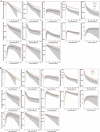Pharmacokinetics under the COVID-19 storm
- PMID: 33226664
- PMCID: PMC7753415
- DOI: 10.1111/bcp.14668
Pharmacokinetics under the COVID-19 storm
Abstract
Aims: The storm-like nature of the health crises caused by COVID-19 has led to unconventional clinical trial practices such as the relaxation of exclusion criteria. The question remains: how can we conduct diverse trials without exposing subgroups of populations to potentially harmful drug exposure levels? The aim of this study was to build a knowledge base of the effect of intrinsic/extrinsic factors on the disposition of several repurposed COVID-19 drugs.
Methods: Physiologically based pharmacokinetic (PBPK) models were used to study the change in the pharmacokinetics (PK) of drugs repurposed for COVID-19 in geriatric patients, different race groups, organ impairment and drug-drug interactions (DDIs) risks. These models were also used to predict epithelial lining fluid (ELF) exposure, which is relevant for COVID-19 patients under elevated cytokine levels.
Results: The simulated PK profiles suggest no dose adjustments are required based on age and race for COVID-19 drugs, but dose adjustments may be warranted for COVID-19 patients also exhibiting hepatic/renal impairment. PBPK model simulations suggest ELF exposure to attain a target concentration was adequate for most drugs, except for hydroxychloroquine, azithromycin, atazanavir and lopinavir/ritonavir.
Conclusion: We demonstrate that systematically collated data on absorption, distribution, metabolism and excretion, human PK parameters, DDIs and organ impairment can be used to verify simulated plasma and lung tissue exposure for drugs repurposed for COVID-19, justifying broader patient recruitment criteria. In addition, the PBPK model developed was used to study the effect of age and ethnicity on the PK of repurposed drugs, and to assess the correlation between lung exposure and relevant potency values from in vitro studies for SARS-CoV-2.
Keywords: ADME; COVID-19; Drug-Drug Interactions; M&S; PBPK; PKPD; cytokine.
© 2020 British Pharmacological Society.
Conflict of interest statement
V.P.R., H.J., N.G., E.L., S.S. and W.T. are all employed by AstraZeneca at the time of this work. E.E. is a PhD student at University of Manchester. A.R.‐H. and M.J. are employed by Certara, a company focusing on model‐informed drug development.
Figures





References
-
- FDA . Enhancing the diversity of clinical trial populations – eligibility criteria, enrollment practices, and trial designs guidance for industry. 2019, https://www.fda.gov/media/127712/download, accsessed 10 October 2020.
-
- Beigel JH, Tomashek KM, Dodd LE, et al. Remdesivir for the treatment of Covid‐19 ‐ preliminary report. N Engl J Med. 2020;383:992‐993. - PubMed
-
- Administration FFD . FDA guidance on conduct of clinical trials of medical products during COVID‐19 public health emergency. 2020, https://www.fda.gov/media/136238/download, accessed 10 October 2020.
Publication types
MeSH terms
Substances
LinkOut - more resources
Full Text Sources
Other Literature Sources
Medical
Miscellaneous

